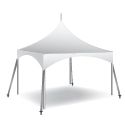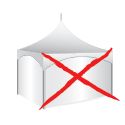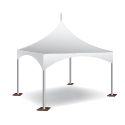What should be done if a marquee tent is up and severe weather/storms are coming?
The #1 concern is Safety: Evacuate the Tent Site. The tent installer/end user is responsible for anticipating and monitoring weather conditions. Failure to evacuate the tent site in severe weather can result in serious injuries or fatalities.
What to do with Tents, Canopies, and Shelters in Severe Weather
Impacts of Inclement Weather on a Tent

Rain: Rainwater can collect on the tent fabric and cause 'ponding' or 'water pocketing' under certain weather conditions, especially if the tent is not installed or tensioned correctly. The additional weight from the water will cause the tent to sag and ponding will continue to get worse. The weight can destroy the tent fabric and/or cause the poles, pole plates, and baseplates to sink into the soil. In addition, highly saturated soil will cause the stakes to lose their holding power. Losing tension from the stakes will cause poles to become unstable, thereby making the structure hazardous.

Wind: Wind or wind with rain can cause the tension of the tent to change by loosening ratchet assemblies, pulling stakes, or causing the poles to shift or sink. It is very important to do routine maintenance checks and maintain proper tension on the tent top at all times, especially if weather conditions are such that ratchets are beginning to loosen.

Lightning: Immediately evacuate the tent until the chance of a lightning strike is no longer present.

Snow: Tents, canopies, structures, and shelters are not designed to carry any type of snow loading. These products should not be used if snow of any kind is present or expected, and must be evacuated immediately in the event of snow loading.
Preparing a Tent for Severe Weather
Tents are temporary structures and typically do not meet any structural codes. In planning for severe weather, Celina recommends that the tent be taken down or the fabric

Tension the Tent: If a tent must be left up in severe weather, it is important that the stakes are secure and the ratchet assemblies and tent top fabric are as tight as possible. Tension each staking point and add additional stakes and stake plates at corner locations, lace lines, and secondary poles. Be aware that significant rainfall can saturate the soil and cause stakes to loosen and possibly fail when combined with heavy wind.

Remove the Sidewalls: When the high wind is expected, sidewalls can be removed from the tent to reduce surface area and therefore reduce wind load pressures. A tent without sidewalls will allow wind to pass through the tent and decrease the chances of side poles being knocked out.

Add Anti-Sink Pole Plates: For pole tents, set all side poles on 6" x 6" anti-sink plates and set center poles on 12" x 12" anti-sink plates. Larger tents may require several pole plates stacked on one another at all center, corner, and lace line pole locations. Anti-sink plates will increase the stability as wind forces are transferred onto the poles; this reduces the effects of the poles sinking into grass, making impressions in asphalt, or sliding on concrete.